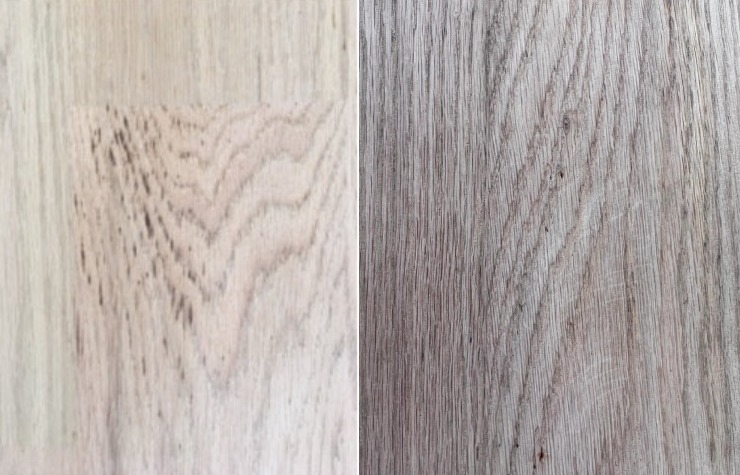Have you noticed small dark spots on your red oak or walnut furniture, especially after we applied a Rubio Monocoat Pre-Color? You might be worried that it’s mold or a defect in the wood. Good news: it’s neither! Those little black marks are actually a natural result of your wood’s own chemistry – something called tannin reacting in the wood. In this post, we’ll explain what tannins are, why these dark spots appear (they’re not mold), and why they’re actually a normal characteristic of real hardwood. We’ll also share how we minimize tannin spots and recommend a few products that can help reduce or remove them. By the end, you’ll feel confident that your furniture is high-quality and beautiful, tiny spots and all.
What Are Tannins in Wood?
Tannins are natural compounds found in many plants and trees – oak, cedar, some mahoganies and walnut happen to have a lot of them. (Fun fact: the word “tannin” comes from leather tanning, since these compounds were used to cure hides.) In trees, tannins serve as a sort of defense mechanism, helping protect against pests and rot. They’re also responsible for rich colors in wood. Generally, lighter-colored woods like maple or birch have very low tannin content, while darker hardwoods like oak, walnut, mahogany, and cherry are rich in tannic acid. So your oak coffee table or walnut dresser is full of natural tannins – that’s part of what gives these woods their beautiful character. If tannins really bothers you, you should avoid choosing oak or walnut furniture.

Tannins in Wood Examples
Now, tannins themselves aren’t visible – they’re just inside the wood but when certain things come into contact with tannins, they can react and produce visible color. If you’ve ever brewed a cup of tea and noticed the brown color, that’s from tannins (tea leaves are high in tannin too!). In wood, tannins can react during finishing or use, which leads to the dark spots we’re discussing.
Why Do Dark Tannin Spots Appear?
Those blackish spots are basically a chemical reaction happening in the wood, often triggered by moisture and metals. Here’s how it works in simple terms:
Water or finish can draw tannins to the surface. When wood gets wet – even with a water-based stain or finish – the moisture can bring the tannic acids up to the wood surface. Rubio Monocoat Pre-Color, for example, is a water-based pre-stain, so it may lift some tannins as it soaks the wood. This is normal for high-tannin woods like red oak.
Tannins + Iron = Dark Spots. If those raised tannins come into contact with iron or steel, a reaction occurs that creates a dark bluish-black discoloration (basically an iron-tannin compound). It’s the same reaction used to intentionally “ebonize” oak wood black using steel wool and vinegar! Even tiny traces of iron can trigger it. For instance, using ordinary tap water (which might have minerals), or microscopic steel dust from cutting tools, or even a metal container touching wet oak can introduce enough iron. Oak is especially sensitive – “oak reacts strongly to iron because of the immense amount of tannins in the wood,” as one wood expert notes. Walnut has tannins too (though a bit less than oak), so it can also get spots, but oak is notoriously reactive.
Certain finishes or cleaners can cause it. Rubio’s Pre-Color or other water-based products don’t contain iron, but water alone can cause tannin movement. Also, if an alkaline product (basic pH) touches tannins, it can turn them brown or gray. Sometimes people unknowingly cause a reaction by using an ammonia-based cleaner or something high pH on oak – that can create greenish-brown tannin spots. But most often, it’s the moisture + metal combo that makes the little black dots.
So, essentially tannic acid in the wood + iron + moisture = dark stain. It might look mysterious, but it’s actually a well-known chemistry. For example, if you leave a wet can or an iron nail on oak, you’ll get a black ring or spot there – it’s called an iron stain. The “mysterious” spots after staining are the same idea, just on a smaller scale. The Rubio Pre-Color (being water-based) likely drew out tannins, and any contact with metal particles or even the steel wool used in prepping (if any was used) can produce those little black freckles.
Dark rings or spots can form when oak or walnut wood comes into contact with moisture and metal, due to the wood’s natural tannic acid reacting with iron. In this example, a wet metal object left on an oak table caused a black ring – a classic tannin reaction, not mold.
It’s Not Mold – Just Mother Nature at Work
Let’s address the elephant in the room: No, these spots are not mold. We understand why someone might think that – the spots are dark and appear after some time, which can resemble mildew stains. But mold on furniture usually has a fuzzy or powdery texture or grows in circular patches. These tannin spots, by contrast, are literally in the wood (not raised on top) and often occur where something contacted the wood (like a bit of metal or water spill).
In fact, wood flooring professionals frequently encounter panicked homeowners who think they have moldy floors, when it’s really tannin staining. As one expert humorously shared, “I get so many calls about ‘mold in my floor’ that I keep repeating my sermon: it’s not mold!”. Our situation is the same – the black dots on your oak/walnut furniture are a natural chemical stain, not a fungal growth. They won’t spread or “infect” anything.
One easy way to tell: if you try to lighten the spots with a wood bleach like oxalic acid (more on that later) and they fade, then it’s definitely an iron-tannin reaction, not mold. Mold wouldn’t bleach out so easily, but iron-tannin black stains do lighten with the right treatment. So rest assured, there’s nothing “growing” in your furniture – it’s simply the wood’s natural tannins showing their presence.
Natural Wood = Natural Character (Not Defects!)
It’s important to remember that when you choose real solid hardwood, you’re choosing a material that has unique character. Unlike manufactured materials (like laminate or engineered wood), which are made to look uniform, genuine wood will have variations in color and grain. Tannin spots are one of those natural variations. They’re like the wood’s birthmarks – part of its personality.
Far from being considered “defects,” features like small knots, mineral streaks, and yes, occasional tannin discoloration are generally allowed in quality standards for hardwood. They show that the piece is authentic and one-of-a-kind. For example, walnut often has little dark streaks or “sap lines” and oak can have what’s called “mineral stain” from elements it absorbed while the tree grew. These are celebrated by woodworkers and furniture makers because they give life to the wood. No two boards are ever exactly alike.
So when you see a couple of dark speckles on your oak table, you can take pride in knowing it’s real oak – the wood is interacting with its environment just as it did when it was part of a tree. Many antique oak furniture pieces have similar blackened areas from where iron hardware contacted them over decades; it gives them a distinguished, antique look. In our case, the spots are smaller, but they are a subtle reminder that your furniture is made of true hardwood with real character. We do not view them as flaws, and we hope you’ll come to view them as a charming aspect of your piece’s natural beauty.
Can We Prevent or Remove These Spots?
We want to be upfront: tannin reactions are a natural phenomenon, so they can be mitigated but not 100% eliminated. Our goal is to minimize any noticeable spots while preserving the integrity of the wood. Here’s how we handle it and what you can expect:
Smart Pre-Finishing Steps: We take extra care during the finishing process to reduce tannin spotting. For instance, we make sure to remove all sanding dust and avoid any contact between raw wood and iron tools or steel wool (steel bits can trigger stains). We might even “water-pop” the wood with distilled water before final finishing – this raises the grain and brings tannins out in a controlled way.
Tannin-Blocking Primers: We also have special products available to neutralize tannins before they react. One example is Rubio Monocoat Tannin Primer, which is a preventive treatment designed for high-tannin woods like oak. It’s not a sealer (it doesn’t stop the oil from penetrating), but it prevents or delays tannin marks from surfacing.
Setting Realistic Expectations: Even with all precautions, you might still find a few faint spots here or there. For example, if there’s an area in the wood with exceptionally high tannin concentrated, it could slightly darken when the finish cures or if the wood gets damp. We believe in honesty, so we let our clients know that completely avoiding any tannin reaction is nearly impossible with real oak/walnut. The wood is organic and will do what nature built it to do. That said, any spots that do appear are usually small and subdued – often only noticeable if you’re looking closely. They typically blend into the rustic charm of the grain. Remember, these are not structural or continuing problems; they won’t spread or worsen. And if a spot truly bothers you, it can be treated(reduced) by Rubio Monocoat Tannin Remover.
Aftercare to Avoid Future Spots: To keep your furniture looking its best, a few tips: use coasters or pads under metal vases or planters (so iron doesn’t sit directly on the wood with moisture), and wipe up spills promptly – especially if the liquid might contain iron or is alkaline. Everyday water spills are generally fine if wiped, but you just don’t want water sitting for long periods. The finish we applied (Rubio Monocoat oil) protects the wood, but it’s still good to be mindful. Also, when cleaning, use a pH-neutral wood cleaner or the manufacturer’s recommended soap. Avoid ammonia-based cleaners on the raw wood or acidic solutions, since those can trigger tannin reactions as mentioned. Following these simple practices will greatly reduce new spots. And if you do get a surprise ring or speckle, you know it can be remedied.
Embracing the Beauty of Real Hardwood
At the end of the day, those small dark spots are a reminder that your furniture is made of genuine, natural wood – a material with a life and story of its own. Rather than viewing tannin marks as blemishes, we encourage our clients to see them the way we do: as a badge of authenticity. They are usually subtle and will likely blend into the patina of your furniture over time, especially as the piece ages gracefully.
Think of it like the freckles on a person’s skin – a few tiny marks that add uniqueness and charm. Your oak or walnut piece isn’t factory-perfect plastic; it’s real wood that has grown in nature, with all the wonderful quirks that come with it. Every board has seen sun and rain, absorbed minerals from the soil, and developed its own character. The fact that it can occasionally react and show a dark spot is part of that character. It’s even possible that, in the future, you’ll come to appreciate these little spots, knowing what they signify.
Most importantly, remember that these tannin spots do not compromise the quality or durability of your furniture in any way. Oak and walnut are hardwoods known for their strength – a few darkened areas don’t change that. We would never deliver a piece of furniture that was actually moldy or defective; what you’re seeing is purely cosmetic and natural. Our goal is always to educate and reassure you, so you feel confident and happy with your investment in real wood furniture.
In Summary:
Tannins are natural compounds in oak and walnut that can cause small dark spots when they react with moisture/metal – it’s a normal chemical reaction in wood, not mold or a flaw.
These spots are a natural characteristic of genuine hardwood. Wood isn’t uniform, and features like this add to its unique beauty. They’re typically minor and not considered defects.
We take steps to minimize tannin staining, like special primers and careful finishing practices, but it can’t be entirely prevented due to wood’s organic nature.
If a black spot does appear, there are treatments to reduce or remove it (e.g. Rubio Tannin Remover or oxalic acid wood bleach). So, any stubborn mark can be lightened if needed – but often it’s so small you may choose to embrace it.
Care tips: Use coasters under metal objects and wipe spills promptly to avoid giving tannins a chance to react. Basic care will keep your furniture looking its best.
We hope this explanation puts your mind at ease. Those little dark spots are actually a sign that you have an authentic piece of oak or walnut furniture, with all the richness and character that entails. In a world of synthetic materials, your furniture stands out as a piece of nature in your home – quirks included! Enjoy the warmth, beauty, and uniqueness of your hardwood furniture, and know that we’re always here to answer any questions about its care.
Thank you for choosing real wood and for trusting us with your furniture. Every knot, grain line, and yes, tannin spot, is part of what makes your piece special. We’re confident it will serve you well and be admired for many years to come. Enjoy your beautiful furniture, and don’t hesitate to reach out if you ever need guidance on maintenance or have concerns – we’re here to help!















